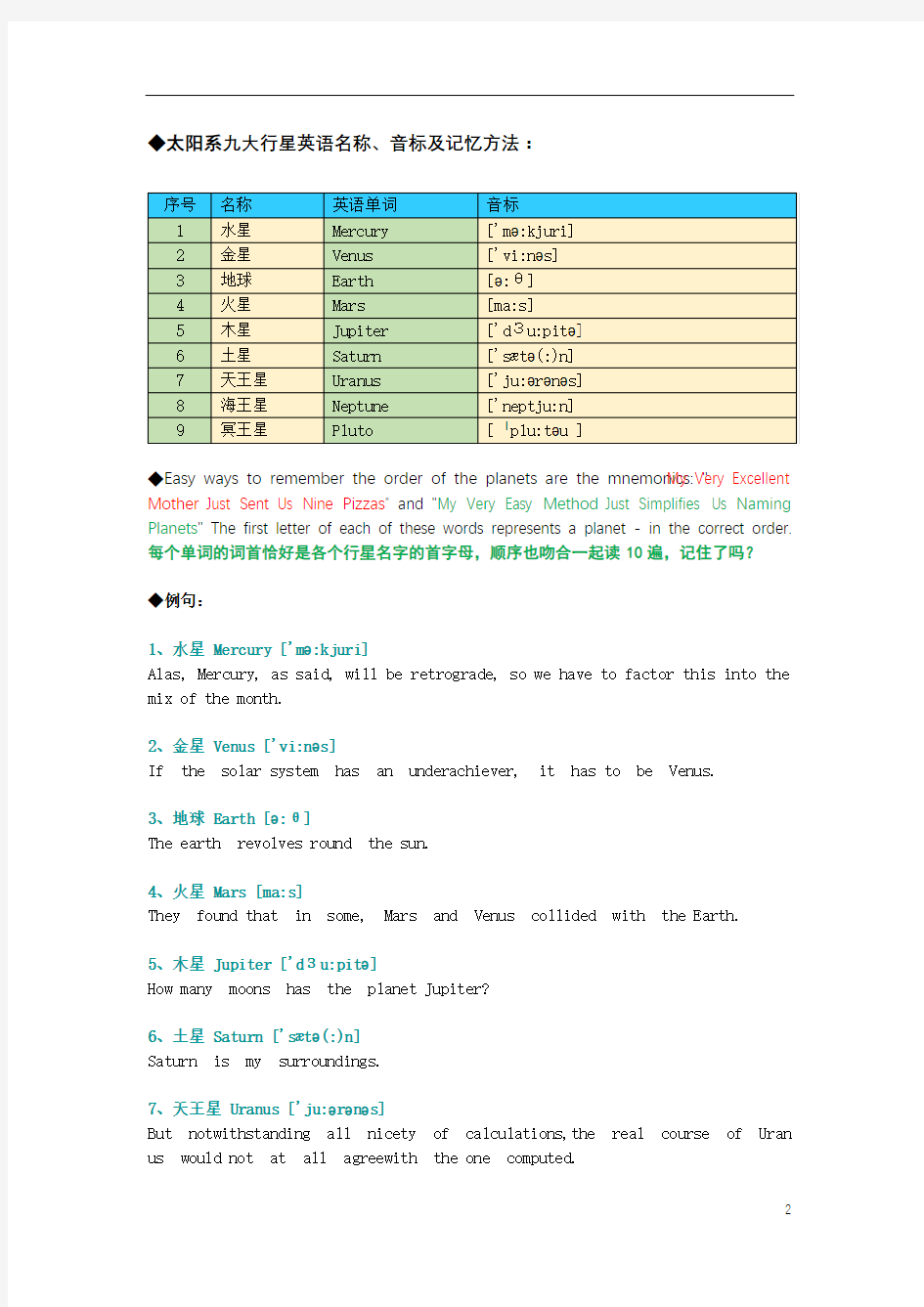九大行星英语名称及音标

- 1、下载文档前请自行甄别文档内容的完整性,平台不提供额外的编辑、内容补充、找答案等附加服务。
- 2、"仅部分预览"的文档,不可在线预览部分如存在完整性等问题,可反馈申请退款(可完整预览的文档不适用该条件!)。
- 3、如文档侵犯您的权益,请联系客服反馈,我们会尽快为您处理(人工客服工作时间:9:00-18:30)。
◆太阳系九大行星英语名称、音标及记忆方法:
◆Easy ways to remember the order of the planets are the mnemonics: "My Very Excellent Mother Just Sent Us Nine Pizzas" and "My Very Easy Method Just Simplifies Us Naming Planets" The first letter of each of these words represents a planet - in the correct order.
每个单词的词首恰好是各个行星名字的首字母,顺序也吻合一起读10遍,记住了吗?
◆例句:
1、水星 Mercury ['mə:kjuri]
Alas, Mercury, as said, will be retrograde, so we have to factor this into the mix of the month.
2、金星 Venus ['vi:nəs]
If the solar system has an underachiever, it has to be Venus.
3、地球 Earth [ə:θ]
The earth revolves round the sun.
4、火星 Mars [ma:s]
They found that in some, Mars and Venus collided with the Earth.
5、木星Jupiter ['dЗu:pitə]
How many moons has the planet Jupiter?
6、土星Saturn ['sætə(:)n]
Saturn is my surroundings.
7、天王星 Uranus ['ju:ərənəs]
But notwithstanding all nicety of calculations,the real course of Uran us would not at all agreewith the one computed.
8、海王星 Neptune ['neptju:n]
The planet was eventually named Neptune, after the Roman god of the sea.
9、冥王星PLUTO [ ˈplu:təu ]
Should Pluto be a planet?
◇九大行星(Solar System)是太阳系的内行星,按照离太阳的距离从近到远,它们依次为水星、金星、地球、火星、木星、土星、天王星、海王星、冥王星。
◇2006年8月24日下午,在第26届国际天文联会通过第5号决议,由天文学家以投票正式将冥王星划为矮行星,自行星之列中除名。
◇八大行星自转方向多数也和公转方向一致,只有金星和天王星两个例外,金星自转方向与公转方向相反,而天王星是在轨道上横滚的。
◆例文:
Our solar system consists of the sun, nine planets (and their moons), an asteroid belt, and many comets and meteors. The sun is the center of our solar system; the planets, their moons, the asteroids, comets, and other rocks and gas all orbit the sun.
The nine planets that orbit the sun are (in order from the sun): Mercury, Venus, Earth, Mars, Jupiter, Saturn, Uranus, Neptune, and Pluto. A belt of asteroids (minor planets made of rock and metal) lies between Mars and Jupiter. These objects all orbit the sun in roughly circular orbits that lie in the same plane, the ecliptic (Pluto is an exception; it has an elliptical orbit tilte d over 17° from the ecliptic).
Easy ways to remember the order of the planets are the mnemonics: "My Very Excellent Mother Just Sent Us Nine Pizzas" and "My Very Easy Method Just Simplifies Us Naming Planets" The first letter of each of these words represents a planet - in the correct order.
The largest planet is Jupiter. It is followed by Saturn, Uranus, Neptune, Earth, Venus, Mars, Mercury, and finally, tiny Pluto. Jupiter is so big that all the other planets could fit inside it.
The Inner Planets vs. the Outer Planets
The inner planets (those planets that orbit close to the sun) are quite different from the outer planets (those planets that orbit far from the sun).
The inner planets are: Mercury, Venus, Earth, and Mars. They are relatively small, composed mostly of rock, and have few or no moons.
The outer planets include: Jupiter, Saturn, Uranus, Neptune, and Pluto. They are mostly huge, mostly gaseous, ringed, and have many moons (again, the exception is Pluto, which is small, rocky, and has one large moon plus two tiny ones).
Temperatures on the Planets
Generally, the farther from the Sun, the cooler the planet. Differences occur when the greenhouse effect warms a planet (like Venus) surrounded by a thick atmosphere.
The outer, gaseous planets are much less dense than the inner, rocky planets.
